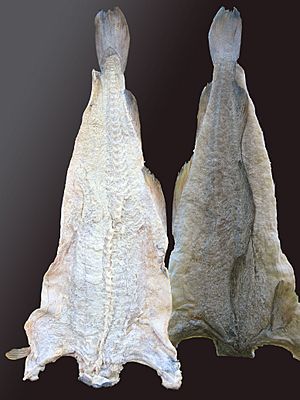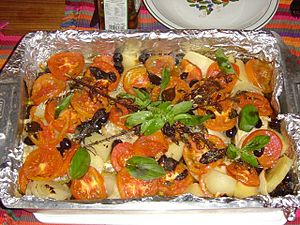Bacalhau facts for kids
Bacalhau is a Portuguese word that means "cod fish." But when people talk about it in cooking, they usually mean cod that has been dried and salted. If the cod is fresh and not salted, it's called bacalhau fresco.
Contents
What is Bacalhau?
Bacalhau is a very important food in Portugal. It's also popular in places that used to be Portuguese colonies, like Brazil, Angola, and Macau. People say there are more than 1,000 different ways to cook bacalhau in Portugal! It's such a big part of Portuguese food that it's often eaten during special times, like Christmas Eve dinner.
You can find similar dried and salted cod dishes in other countries too. For example, in Norway, there's a dish called bacalao. It's made with salted cod, potatoes, onions, tomatoes, and olives.
For a long time, most of the salted and dried cod came from big fishing areas in the North Atlantic Ocean, like the Grand Banks near Newfoundland. It used to be a cheap food. But after cod fish numbers went down, it became more expensive, especially around holidays like Easter and Christmas.
Cooking with Bacalhau
There are so many ways to cook bacalhau that some people say there's a different recipe for every day of the year! It's a very common ingredient in Portuguese kitchens.
Bacalhau is often served with potatoes or sweet potatoes and fresh bread. People like to add flavors like garlic, onion, olive oil, and different spices. It tastes great with Portuguese wines like vinho verde.
Here are just a few of the many popular bacalhau dishes:
- Bacalhau à Brás
- Bacalhau à Gomes de Sá
- Bacalhau com natas (Bacalhau with cream)
- Bolinhos de bacalhau (small cod cakes)
- Pataniscas (fritters made with bacalhau)
How Bacalhau is Protected
The special way that bacalhau is made in Portugal is protected in Europe and the UK. This means that only bacalhau made using traditional Portuguese methods can be called Bacalhau de Cura Tradicional Portuguesa. This helps keep the quality and tradition of this food.
The History of Salted Cod
People have been making salt cod for at least 500 years! This started around the time Europeans first explored the New World. Before we had refrigerators, people needed ways to keep food from spoiling. Drying and salting fish were old ways to do this. These methods also made the cod taste even better. Cod fish are good for drying because they don't have much oil or fat in their meat.
Fishermen from Portugal, England, and other parts of Europe learned how to salt and dry cod from Basque fishermen in Newfoundland in the late 1500s. By the 1700s, salted cod was a very important food for everyone in Portugal.
Later, with new ways to freeze and transport food, less salted cod came from North America. Instead, Iceland and Norway became the main places that supplied salted fish to Portugal. During this time, bacalhau was a cheap way to get protein. It became a basic food in Portuguese cooking and was even called fiel amigo, which means "loyal friend." In Portugal, when people say "cod," they almost always mean the salted, dried kind. It's rare to find fresh cod for sale there.
Bacalhau is also popular in Portugal and other Catholic countries because of religious traditions. In the past, the Church asked people not to eat meat on certain days, like Fridays or during Lent. So, bacalhau dishes were eaten instead.
In Portugal, you can often buy bacalhau without a brand name. Customers can touch and smell the fish to pick the best one. Stores have many different kinds of bacalhau, which can vary in color, size, smell, and how dry they are. The fish are also sorted by weight. The biggest pieces are called Especial (over 4kg), and the smallest are Miúdo (under 500g).



